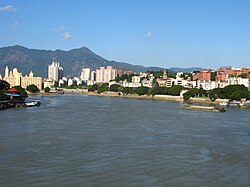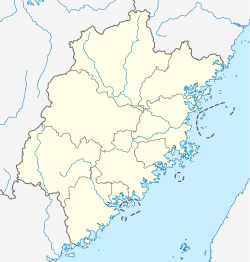(Redirected from
Cangshan District)
Cangshan
仓山区 | |
|---|---|
 Min River side of Cangshan | |
|
Location in Fuzhou | |
| Coordinates: 26°03′18″N 119°18′58″E / 26.05500°N 119.31611°E | |
| Country | People's Republic of China |
| Province | Fujian |
| Prefecture-level city | Fuzhou |
| Area | |
| • Total | 139 km2 (54 sq mi) |
| Population (2020) | 1,142,991 |
| Time zone | UTC+8 ( China Standard) |
| Postal code | 350007 |
| Area code | 0591 |
| GDP (2020) | CN¥ 90.22 billion |
| Website |
cs |
Cangshan District ( simplified Chinese: 仓山区; traditional Chinese: 倉山區; pinyin: Cāngshān Qū, Fuzhou dialect: Chŏng-săng) is one of 6 urban districts of the prefecture-level city of Fuzhou, the capital of Fujian Province, China.
History
- Cangshan District was formerly known as "Guatengshan" (literally, "Melon Vine Mountain"), also known as "Tengshan" (literally, "Vine Mountain"), with a watchtower at the top of the mountain. Therefore, it was also called the Yan Tai Mountain (literally, "Smoke Platform Mountain"), named after the Zhongzhou barbette (Zhongzhou Pao Tai, literally, "Zhongzhou Cannon Platform"). Because a salt warehouse was built there in Ming dynasty, the place was also called Cangqianshan (literally, "the mountain before the warehouse"), abbreviated to Cangshan, which is where the modern name comes from. [1] [2]
- The Treaty of Nanking in 1842 listed Fuzhou (Fuchow) as one of the Five Ports of Treaty, which made Cangshan District become the historic district for consulates. In 1844–1903, there built consulates of the United Kingdom, the United States of America, France, Russia, Japan, the Netherlands, Portugal, Spain, etc. [3] [4] At the same time, many Christian churches, schools, hospitals, newspaper offices, western firms were built there. Because of this history, there still exist some Gothic-style buildings and Romanesque-style buildings today, which become the iconic style of Cangshan District. [5] Since the year 2005, because of the "transformation of the old district" project, some characteristic buildings were torn down and rebuilt, which triggered some social opposition. [6] [7] [8] [9]
Geography
- Cangshan District is located in the south part of downtown Fuzhou, including entire Nantai Island, and a few sand islands on the Min River. Cangshan District is next to Gulou District, Taijiang District, Jin'an District, Mawei District, Changle District and Minhou County. The area of Cangshan District is about 142 square kilometres. [10]
- Cangshan District is surrounded by the Min River main branch (or north branch) and the Wulong River (the Min River south branch). The Min River (main branch) and Wulong River converge on Mawei District and ultimately flows to the Taiwan Strait. [11]
- There are plenty of mountains and hills in Cangshan District, e.g. Gaogai Mountain, Chang'an Mountain, Yantai Mountain, etc. In the centre of the former urban area (i.e. Cangshan proper), there were full of plum blossoms and therefore the road is today known as the Meiwu Road (literally, "plum blossom hollow road"). People used to visit there annually to enjoy the plum blossoms, which was an important annual event. [12]
Administrative divisions
Subdistricts:
- Cangqian Subdistrict ( Chinese: 仓前街道; pinyin: Cāngqián Jiēdào)
- Dongsheng Subdistrict ( Chinese: 东升街道; pinyin: Dōngshēng Jiēdào)
- Duihu Subdistrict ( Chinese: 对湖街道; pinyin: Duìhú Jiēdào)
- Jinshan Subdistrict ( Chinese: 金山街道; pinyin: Jīnshān Jiēdào)
- Linjiang Subdistrict ( Chinese: 临江街道; pinyin: Línjiāng Jiēdào)
- Sanchajie Subdistrict ( Chinese: 三叉街街道; pinyin: Sānchājiē Jiēdào)
- Shangdu Subdistrict ( Chinese: 上渡街道; pinyin: Shàngdù Jiēdào)
- Xiadu Subdistrict ( Chinese: 下渡街道; pinyin: Xiàdù Jiēdào)
Towns:
- Cangshan ( Chinese: 仓山镇; pinyin: Cāngshān Zhèn)
- Chengmen ( Chinese: 城门镇; pinyin: Chéngmén Zhèn)
- Gaishan ( Chinese: 盖山镇; pinyin: Gàishān Zhèn)
- Jianxin ( Chinese: 建新镇; pinyin: Jiànxīn Zhèn)
- Luozhou ( Chinese: 螺洲镇; pinyin: Luózhōu Zhèn)
Tourist attractions
See also
References
- ^ "福州仓山卫星地图". 福州城镇地图. Archived from the original on 7 June 2020.
- ^ "渐行渐远老福州". 小林的摄影绘画文字. 18 January 2010. Archived from the original on 7 June 2020.
- ^ 陈兆奋; 陈建中 (5 July 2007). "各国驻福州领事馆追踪". 福州市档案局(馆). Archived from the original on 2 April 2015.
- ^ "二、外国驻闽机构". 福建省情资料库 地方志之窗. Archived from the original on 2 April 2015.
- ^ "Yan Tai Mountain – A Forgotten History of Fuzhou". Fuzhou Expat. 4 May 2018. Archived from the original on 11 June 2020. Retrieved 11 June 2020.
- ^ "福州市城市交通项目". 7 March 2005. Archived from the original on 7 June 2020. Retrieved 7 June 2020.
- ^ "德园". 福州老建筑百科. Archived from the original on 7 June 2020. Retrieved 7 June 2020.
- ^ "加拿大都市报:华侨钉子户向海外求助". 澳奇网. 5 December 2007. Archived from the original on 7 June 2020. Retrieved 7 June 2020.
- ^ "师大旧学生街这次真的要拆了!福州人,对不起!你的青春将被拆除!". 新浪新闻中心. 18 December 2018. Archived from the original on 7 June 2020. Retrieved 7 June 2020.
- ^ "仓山区自然人文". 福州市仓山区人民政府. 12 May 2019. Archived from the original on 7 June 2020. Retrieved 7 June 2020.
- ^ ""老仓山"之外,还有你不知道的宝藏仓山". 腾讯网. 8 May 2020. Archived from the original on 7 June 2020. Retrieved 7 June 2020.
- ^ "为仓山区地区提供专业的翻译服务". 新译通翻译公司. Archived from the original on 7 June 2020.
External links
Wikimedia Commons has media related to
Cangshan District.
- Cangshan Government, Fuzhou (in Chinese).
